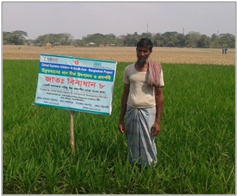Pashchim Shariakhali is a village under Patuakhali Sadar upazila with almost 2,000 resident farm families where agriculture is the only source of livelihood. Five to six years ago, villages there used to cultivate two to three crops in a year and earn a reasonable income from it. Today, most of the villagers cultivate only during aman season due to salinity problems. In the last boro season, Bihango Mohila Sangstha (BMS), NGO partner of CSISA-BD SRSPDS, organized a training event at Pashchim Shariakhali for production of newly developed salt-tolerant rice varieties: Binadhan-8 and BRRI dhan47.

Mr. Sobhan Boyati in his field of salt tolerant rice
After the benefits of these varieties were explained, farmers in the village had difficulty believing that rice varieties could survive where salinity levels reached 12 dS per meter. The BMS Executive Director, assured farmers that she would compensate all production costs if they grow these varieties and their work was not successful. Eight farmers agreeing to participate subsequently received both seeds and training on the cultivation technology of salt-tolerant rice varieties by government agriculture extension officials. Mr. Sobhan Boyati took the lead in setting up his plots and closely monitored them along with the concerned NGO, local government agricultural officials (DAE), and SRSPDS staff. At the end of the season, the harvested rice production was beyond what they imagined – it was difficult for them to believe such a crop could be grown during the boro season due to the high salinity. Farmers discovered that not only were these varieties salt-tolerant, they were also high yielding and resistant to insects and diseases. Average yield among the eight farmers was 4.7 tons/ha, quite satisfactory for the salt-affected area. Sultan Mridha, a farmer from the prior year, established a demonstration with Binadhan-8 and got a bumper production of 6.5 tons/ha. He made about BDT 26,000, which was more than double from the previous season. In addition, he preserved rice seed for his own use and also for sale to several neighboring farmers. The picture for the current boro season is encouraging with neighboring farmers receiving seed from the 8 farmers mentioned previously.

